Text
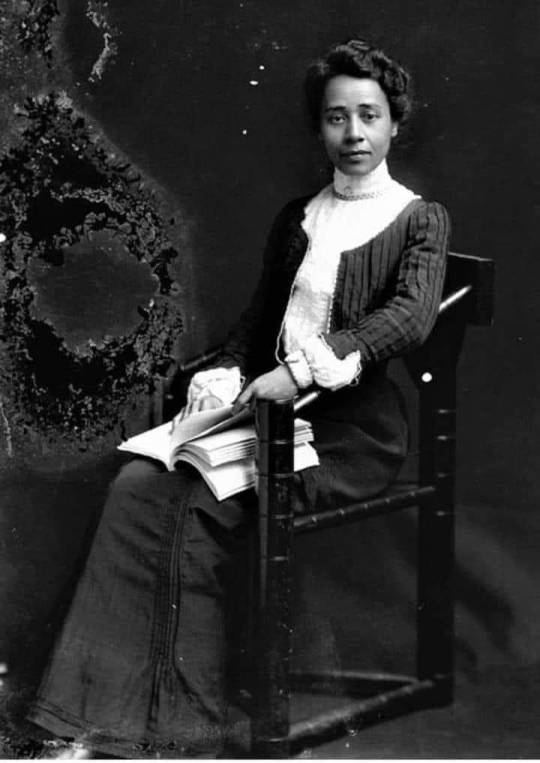
𝗔𝗡𝗡𝗔 𝗝𝗨𝗟𝗜𝗔 𝗛𝗔𝗬𝗪𝗢𝗢𝗗 𝗖𝗢𝗢𝗣𝗘𝗥 (1858-1964)
Anna Julia Haywood Cooper was a writer, teacher, and activist who championed education for African Americans and women. Born into bôndage in 1858 in Raleigh, North Carolina, she was the daughter of an enslaved woman, Hannah Stanley, and her owner, George Washington Haywood.
In 1867, two years after the end of the Civil Wàr, Anna began her formal education at Saint Augustine’s Normal School and Collegiate Institute, a coeducational facility built for former slàves. There she received the equivalent of a high school education.
Anna Haywood married George A.G. Cooper, a teacher of theology at Saint Augustine’s, in 1877. When her husband died in 1879, Cooper decided to pursue a college degree. She attended Oberlin College in Ohio on a tuition scholarship, earning a BA in 1884 and a Masters in Mathematics in 1887. After graduation Cooper worked at Wilberforce University and Saint Augustine’s before moving to Washington, D.C. to teach at Washington Colored High School. She met another teacher, Mary Church (Terrell), who, along with Cooper, boarded at the home of Alexander Crummell, a prominent clergyman, intellectual, and proponent of African American emigration to Liberia.
Cooper published her first book, A Voice from the South by a Black Woman of the South, in 1892. In addition to calling for equal education for women, A Voice from the South advanced Cooper’s assertion that educated African American women were necessary for uplifting the entire black race. The book of essays gained national attention, and Cooper began lecturing across the country on topics such as education, civil rights, and the status of black women. In 1902, Cooper began a controversial stint as principal of M Street High School (formerly Washington Colored High). The white Washington, D.C. school board disagreed with her educational approach for black students, which focused on college preparation, and she resigned in 1906.
In addition to working to advance African American educational opportunities, Cooper also established and co-founded several organizations to promote black civil rights causes. She helped found the Colored Women’s League in 1892, and she joined the executive committee of the first Pan-African Conference in 1900. Since the Young Women’s Christian Association (YWCA) and the Young Men’s Christian Association (YMCA) did not accept African American members, she created “colored” branches to provide support for young black migrants moving from the South into Washington, D.C.
Cooper resumed graduate study in 1911 at Columbia University in New York City, New York. After the death of her brother in 1915, however, she postponed pursuing her doctorate in order to raise his five grandchildren. She returned to school in 1924 when she enrolled at the University of Paris in France. In 1925, at the age of 67, Cooper became the fourth African American woman to obtain a Doctorate of Philosophy.
In 1930, Cooper retired from teaching to assume the presidency of Frelinghuysen University, a school for black adults. She served as the school’s registrar after it was reorganized into the Frelinghuysen Group of Schools for Colored People. Cooper remained in that position until the school closed in the 1950s.
Anna Julia Cooper dièd in 1964 in Washington, D.C. at the age of 105.
#anna cooper#black tumblr#black history#black literature#black community#black excellence#civil rights#black history is american history#black girl magic#blackexcellence365
60 notes
·
View notes
Text

Maria Priscilla Thurston Williams (1866–1932) was a newspaper editor, film producer, author, and scriptwriter. She is credited as the first African-American woman film producer for the silent crime drama The Flames of Wrath in 1923. A one-time school teacher, Williams had a history of activism, independence and interest in the liberal arts, which led her first to newspapers, then to film production, script-writing and acting and, finally, to memoir with her 1916 book My Work and Public Sentiment, in which she identified herself as a national organizer and speaker with the Good Citizens League, and stated that ten percent of the proceeds would go to suppressing crime among African Americans.
#black tumblr#black literature#black history#black excellence#black community#civil rights#black history is american history#black girl magic#blackexcellence365
15 notes
·
View notes
Text

Una Mae Carlisle (December 26, 1915 – November 7, 1956)[1] was an American jazz singer, pianist, and songwriter. Carlisle was born in Zanesville, Ohio, the daughter of Mellie and Edward Carlisle. She was of African and Native American descent. Trained to play piano by her mother, she was performing in public by age three.
10 notes
·
View notes
Text

Fredericka Carolyn "Fredi" Washington (December 23, 1903 – June 28, 1994) was an American stage and film actress, civil rights activist, performer, and writer. Washington was of African American descent. She was one of the first Black Americans to gain recognition for film and stage work in the 1920s and 1930s.
Washington was active in the Harlem Renaissance (1920s–1930s), her best known role being Peola in the 1934 film version of Imitation of Life, where she plays a young light-skinned Black woman who decides to pass as white. Her last film role was in One Mile from Heaven (1937), after which she left Hollywood and returned to New York to work in theatre and civil rights activism.
#fredi washington#black tumblr#black literature#black history#black community#black excellence#civil rights#black history is american history#black girl magic#blackexcellence365
24 notes
·
View notes
Text
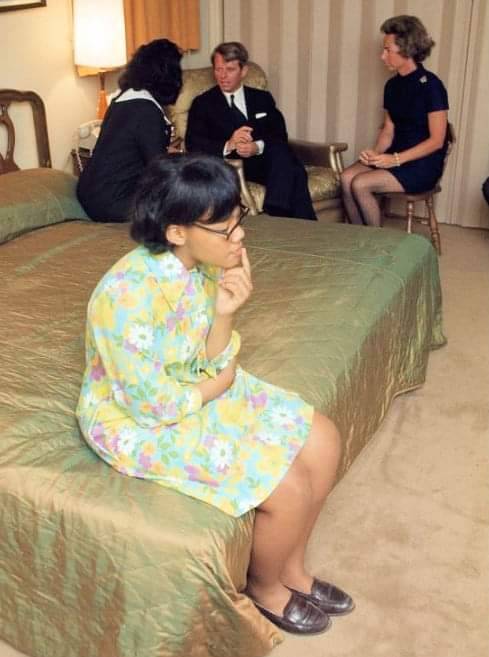
Yolanda King, Coretta Scott King, Robert Kennedy and Ethel Kennedy.
#black tumblr#coretta scott king#yolanda king#black literature#black history#black excellence#robert kennedy jr#black community#civil rights#black history is american history#civil rights movement#black girl magic#blackexcellence365#ethel kennedy#black history month#black lives matter
24 notes
·
View notes
Text
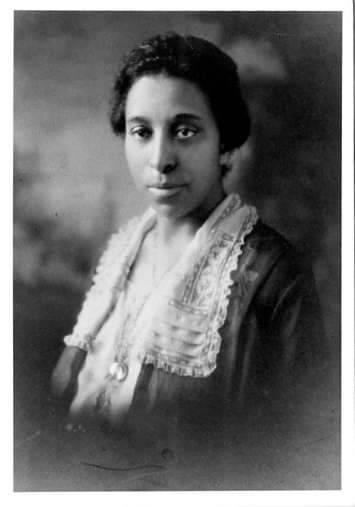
Lucy Diggs Slowe (July 4, 1885 – October 21, 1937) was an American educator and athlete, and the first Black woman to serve as Dean of Women at any American university. She was a founder of Alpha Kappa Alpha sorority, the first sorority founded by African-American women.
Slowe was a tennis champion, winning the national title of the American Tennis Association's first tournament in 1917, the first African-American woman to win a major sports title. In 1922, Slowe was appointed the first Dean of Women at Howard University. She continued in that role for 15 years until her death. In addition, Slowe created and led two professional associations to support college administrators.
Lucy Diggs Slowe was born in Berryville, Virginia to Henry Slowe and Fannie Potter Slowe. While various sources put her birth year as 1885,[3][4] others have said 1883. She was one of seven children. Her father's occupation has been reported as a hotel operator, restaurant proprietor and farmer. He died before Lucy turned one and her mother died shortly after. Following her mother's death, Lucy and her sister Charlotte were raised by her aunt Martha Price in Lexington, Virginia. At thirteen, Lucy and her family moved to Baltimore, Maryland, where she attended the Baltimore Colored High and Training School. She graduated second in her class in 1904, receiving one of the two-sponsored scholarships to Howard from the Baltimore City School Board.
Slowe was the first person from her school to attend Howard University, the top historically black college in the nation, at a time when only 1/3 of 1% of African Americans and 5% of whites of eligible age attended any college.
After graduation in 1908, Slowe returned to Baltimore to teach English in high school. During the summers, she started studying at Columbia University in New York, where she earned her Masters of Arts degree in 1915.
#black tumblr#black history#black literature#black excellence#black community#civil rights#black history is american history#black girl magic
89 notes
·
View notes
Text
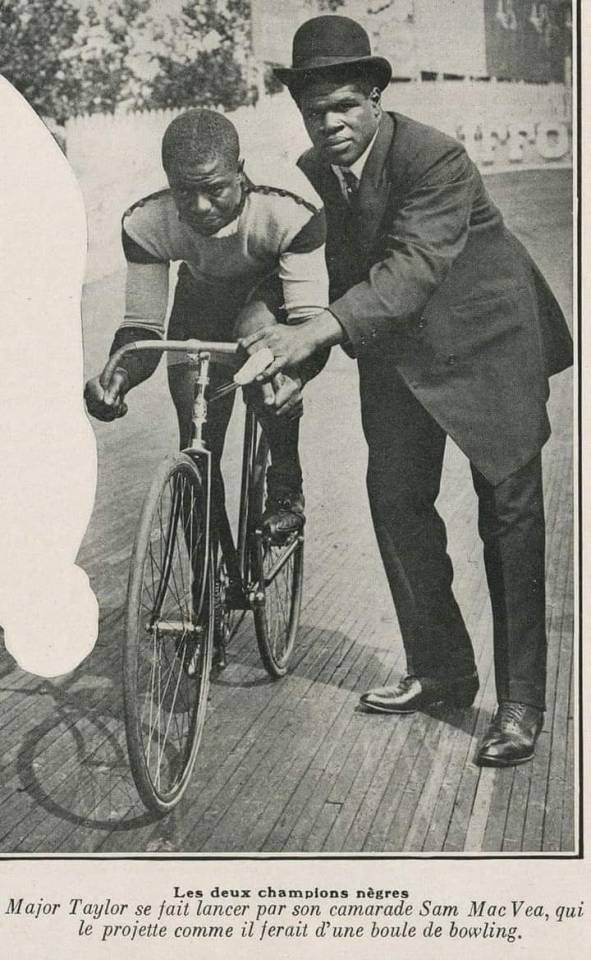
Marshall Walter "Major" Taylor (November 26, 1878 – June 21, 1932) was an African-American professional cyclist. Even by modern cycling standards, Taylor could be considered the greatest American sprinter of all time.
Taylor's legacy lies in his willingness to challenge racial prejudice as an African American athlete in the white-dominated sport of cycling. He was also hailed as a sports hero in France and Australia. Taylor, who became a role model for other athletes facing racial prejudice and discrimination, was "the first great black celebrity athlete" and a pioneer in his efforts to challenge segregation in sports. He also paved the way for others facing similar circumstances. Taylor explained in his autobiography that he had no other African Americans to offer him advice and "therefore had to blaze my own trail."
#black tumblr#black history#black literature#black excellence#black community#civil rights#black history is american history#blackexcellence365#cyclist
231 notes
·
View notes
Text

Paul Adams 1920-2013, joined the Tuskegee Airmen shortly after graduating from South Carolina State University. He flew with the 332nd Fighter Squadron (the famed "Red Tails") throughout WWII. He would retire from the military in 1962. He then would become a teaching in the Lincoln (NE) public school system. They named Adams Elementary school for him in 2008.
Paul Adams and his fellow Tuskegee Airmen were the first African-American aviators in the U.S. military, whose distinguished record many historians credit with helping pave the way for the civil rights movement.
The group set an unprecedented record, flying more than 1,500 missions in Europe and North Africa. Adam served in nine major campaigns and received the Commendation Medal with three Oak Leaf clusters, each of which signifies subsequent bestowals of the same honor.
Doane College recognized him with the President's Honor of Distinction Award the same year. In 2007, he received the Congressional Gold Medal along with other Tuskegee Airmen, who were known as "guardian angels" by white airmen who were escorted by the African-American pilots during the war. Adams received a bronze replica at a ceremony in Lincoln. Doane College recognized him with the President's Honor of Distinction Award the same year.
And two years later, Adams, at President Barack Obama's invitation, attended the inauguration of the first black president along with other Tuskegee Airmen. Adams went on to become one of the first black teachers in LPS, and in 2008, his accomplishments were honored when the district named a new school after him.
He became a frequent visitor at Adams Elementary, where books about Tuskegee Airmen fill the library and teachers make a point to read them to students. The history became an integral part of Adams Elementary school
#black tumblr#black history#black literature#black excellence#black community#civil rights#black history is american history#blackexcellence365#tuskegee airmen#american history
185 notes
·
View notes
Text

Edna Mae Harris (September 29, 1914 – September 15, 1997), sometimes credited as Edna May Harris was an American actress and singer. Harris was one of the first African–American film actress of the late 1930s and early 1940s, appearing in films featuring mostly African–American casts.
Born in Harlem, Harris parents were Sam, a boxer and customs inspector; Her mother Mary Harris (née Walker) worked as a maid. Harris' family is noted as one of the first families to have migrated to Harlem. Settling near the Lafayette Theater, Harris was convinced into pursuing a career in show business by Ethel Waters and Maud Russell who were frequent visitors to her family home. After being coached on her singing and dancing by Waters and Russell, Harris began performing in the Theater Owners Booking Association (TOBA). An African-American vaudeville circuit, Harris performed with TOBA from 1929 until 1933.
Harris attended Wadleigh High School (later known as Wadleigh High School for Girls) in Manhattan. During the summer after her sophomore year of high school, Harris worked at the Alhambra Theater doing dramatic sketches with a stock company. During this period, Harris received excellent training in diction and stage delivery through her association with veteran performers. Harris was also an excellent swimmer in high school, and in 1928 she entered the New York Daily News' Swimming Meet and won a championship.
Harris first real Hollywood break came when she landed a part in The Green Pastures (1936), portraying Zeba, starring with Eddie 'Rochester' Anderson. Harris was a leading lady in Spirit of Youth (1938), the story of the rise of boxer Joe Thomas, which paralleled the life of Joe Louis. Harris also had leading roles in Oscar Micheaux films, Lying Lips (1939), and The Notorious Elinor Lee (1940). Her film credits also include such Hollywood films as Bullets or Ballots (1936), Private Number (1936), and Garden of Allah (1936), and the independent film Paradise in Harlem in 1939. Between picture commitments she toured with Noble Sissle's Orchestra as a featured vocalist along with Lena Horne and Billy Banks. In 1942, she played fourteen weeks at the old Elks' Rendezvous as the mistress of ceremonies and announced a weekly radio show over station WMCA in New York City. She also did character dialect parts on many broadcasts for the Columbia Workshop Program. Edna Mae Harris got to tell her story in her later years in the documentary, Midnight Ramble (1994), about independently produced black films.
Harris was married twice and had no children. Her first marriage was to Edward Randolph from 1933 until 1938, then to Harlem nightclub owner Walter Anderson from 1951 until his death in 1983. Harris dated boxer Joe Louis sometime during 1939 and 1940. Harris dated Robert Paquin, who co-starred with her in the Lying Lips from 1941 until 1942. Harris died of a heart attack on September 15, 1997 at the age of 82.
#black literature#black tumblr#black excellence#black community#civil rights#black girl magic#blackexcellence365#beautiful#strong black woman
12 notes
·
View notes
Text

FATHER & SON: James Earl Jones with his Father Robert Earl Jones on Stage in the 1962 Production "Moon on a Rainbow Shawl."
Robert Earl Jones (February 3, 1910 – September 7, 2006), sometimes credited as Earl Jones, was an American actor and professional boxer. One of the first prominent Black film stars, Jones was a living link with the Harlem Renaissance of the 1920s and 1930s, having worked with Langston Hughes early in his career.
Jones was best known for his leading roles in films such as Lying Lips (1939) and later in his career for supporting roles in films such as The Sting (1973), Trading Places (1983), The Cotton Club (1984), and Witness (1985).
Jones was born in northwestern Mississippi; the specific location is unclear as some sources indicate Senatobia, while others suggest nearby Coldwater. He left school at an early age to work as a sharecropper to help his family. He later became a prizefighter. Under the name "Battling Bill Stovall", he was a sparring partner of Joe Louis.
Jones became interested in theater after he moved to Chicago, as one of the thousands leaving the South in the Great Migration. He moved on to New York by the 1930s. He worked with young people in the Works Progress Administration, the largest New Deal agency, through which he met Langston Hughes, a young poet and playwright. Hughes cast him in his 1938 play, Don't You Want to Be Free?.
Jones also entered the film business, appearing in more than twenty films. His film career started with the leading role of a detective in the 1939 race film Lying Lips, written and directed by Oscar Micheaux, and Jones made his next screen appearance in Micheaux's The Notorious Elinor Lee (1940). Jones acted mostly in crime movies and dramas after that, with such highlights as Wild River (1960) and One Potato, Two Potato (1964). In the Oscar-winning 1973 film The Sting, he played Luther Coleman, an aging grifter whose con is requited with murder leading to the eponymous "sting". In the later 20th century, Jones appeared in several other noted films: Trading Places (1983) and Witness (1985).
Toward the end of his life, Jones was noted for his stage portrayal of Creon in The Gospel at Colonus (1988), a black musical version of the Oedipus legend. He also appeared in episodes of the long-running TV shows Lou Grant and Kojak. One of his last stage roles was in a 1991 Broadway production of Mule Bone by Hughes and Zora Neale Hurston, another important writer of the Harlem Renaissance. His last film was Rain Without Thunder (1993).
Although blacklisted by the House Un-American Activities Committee in the 1950s due to involvement with leftist groups, Jones was ultimately honored with a lifetime achievement award by the U.S. National Black Theatre Festival.
Jones was married three times. As a young man, he married Ruth Connolly (died 1986) in 1929; they had a son, James Earl Jones. Jones and Connolly separated before James was born in 1931, and the couple divorced in 1933. Jones did not come to know his son until the mid-1950s. He adopted a second son, Matthew Earl Jones. Jones died on September 7, 2006, in Englewood, New Jersey, from natural causes at age 96.
THEATRE
1945 The Hasty Heart (Blossom) Hudson Theatre, Broadway
1945 Strange Fruit (Henry) McIntosh NY theater production
1948 Volpone (Commendatori) City Center
1948 Set My People Free (Ned Bennett) Hudson Theatre, Broadway
1949 Caesar and Cleopatra (Nubian Slave) National Theatre, Broadway
1952 Fancy Meeting You Again (Second Nubian) Royale Theatre, Broadway
1956 Mister Johnson (Moma) Martin Beck Theater, Broadway
1962 Infidel Caesar (Soldier) Music Box Theater, Broadway
1962 The Moon Besieged (Shields Green) Lyceum Theatre, Broadway
1962 Moon on a Rainbow Shawl (Charlie Adams) East 11th Street Theatre, New York
1968 More Stately Mansions (Cato) Broadhurst Theatre, Broadway
1975 All God's Chillun Got Wings (Street Person) Circle in the Square Theatre, Broadway
1975 Death of a Salesman (Charley)
1977 Unexpected Guests (Man) Little Theatre, Broadway
1988 The Gospel at Colonus (Creon) Lunt-Fontanne Theatre, Broadway
1991 Mule Bone (Willie Lewis) Ethel Barrymore Theatre, Broadway
FILMS
1939 Lying Lips (Detective Wenzer )
1940 The Notorious Elinor Lee (Benny Blue)
1959 Odds Against Tomorrow (Club Employee uncredited)
1960 Wild River (Sam Johnson uncredited)
1960 The Secret of the Purple Reef (Tobias)
1964 Terror in the City (Farmer)
1964 One Potato, Two Potato (William Richards)
1968 Hang 'Em High
1971 Mississippi Summer (Performer)
1973 The Sting (Luther Coleman)
1974 Cockfighter (Buford)
1977 Proof of the Man (Wilshire Hayward )
1982 Cold River (The Trapper)
1983 Trading Places (Attendant)
1983 Sleepaway Camp (Ben)
1984 The Cotton Club (Stage Door Joe)
1984 Billions for Boris (Grandaddy)
1985 Witness (Custodian)
1988 Starlight: A Musical Movie (Joe)
1990 Maniac Cop 2 (Harry)
1993 Rain Without Thunder (Old Lawyer)
TELEVISION
1964 The Defenders (Joe Dean) Episode: The Brother Killers
1976 Kojak (Judge) Episode: Where to Go if you Have Nowhere to Go?
1977 The Displaced Person (Astor) Television movie
1978 Lou Grant (Earl Humphrey) Episode: Renewal
1979 Jennifer's Journey (Reuven )Television movie
1980 Oye Ollie (Performer) Television series
1981 The Sophisticated Gents (Big Ralph Joplin) 3 episodes
1982 One Life to Live
1985 Great Performances (Creon) Episode: The Gospel at Colonus
1990 True Blue (Performer) Episode: Blue Monday
#james earl jones#black tumblr#black literature#black community#black excellence#blackexcellence365#actor#robert earl jones#stage actor
158 notes
·
View notes
Text

Eva Beatrice Dykes (13 August 1893 – 29 October 1986) was a prominent educator and the third black American woman to be awarded a PhD.
Dykes was born in Washington, D.C., on August 13, 1893, the daughter of Martha Ann (née Howard) and James Stanley Dykes. She attended M Street High School (later renamed Dunbar High School). She graduated summa cum laude from Howard University with a B.A. in 1914. While attending Howard University, where several family members had studied, Eva was initiated into the Alpha chapter of Delta Sigma Theta. At the end of her last semester she was awarded Alpha Kappa Alpha Sorority Incorporated's first official scholarship. After a short stint of teaching at Walden University in Nashville, Tennessee, Dykes attended Radcliffe College graduating magna cum laude with a second B.A. in 1917 and a M.A in 1918. While at Radcliffe she was elected to Phi Beta Kappa. In 1920 Dykes began teaching at Dunbar High School, and in 1921 she received a PhD from Radcliffe (now a part of Harvard University). Her dissertation was titled “Pope and His influence in America from 1715 to 1815”, and explored the attitudes of Alexander Pope towards slavery and his influence on American writers. Dykes was the first black American woman to complete the requirements for a doctoral degree, however, because Radcliffe College held its graduation ceremonies later in the spring, she was the third to graduate, behind Sadie Tanner Mossell Alexander (1921, University of Pennsylvania) and Georgiana R. Simpson (1921, University of Chicago).
After her graduation from Radcliffe in 1921, Dykes continued to teach at Dunbar High School until 1929 when she returned to Howard University as a member of the English Faculty. An excellent teacher, Dykes won a number of teaching awards during her 15 years of service at Howard University. Her publications include Readings from Negro Authors for Schools and Colleges co-authored with Lorenzo Dow Turner and Otelia Cromwell (1931) and The Negro in English Romantic Thought: Or a Study in Sympathy for the Oppressed (1942). In 1934 Dykes began writing a column in the Seventh-day Adventist periodical Message Magazine, this continued until 1984.
In 1920 Dykes joined the Seventh-day Adventist Church, and in 1944 she joined the faculty of the then small and unaccredited Seventh-day Adventist Oakwood College in Huntsville, Alabama, as the Chair of the English Department. She was the first staff member at Oakwood to hold a doctoral qualification and was instrumental in assisting the college to gain accreditation. Dykes retired in 1968 but returned to Oakwood to teach in 1970 and continued until 1975. In 1973 the Oakwood College library was named in her honor and in 1980 she was made a Professor Emerita. In 1975 the General Conference of the Seventh-day Adventist Church presented Dykes with a Citation of Excellence honouring her for an outstanding contribution to Seventh-day Adventist education. Dykes died in Huntsville on October 29, 1986, at the age of 93.
#black history#black literature#black tumblr#black excellence#black community#civil rights#black history is american history#black girl magic#blackexcellence365
84 notes
·
View notes
Text
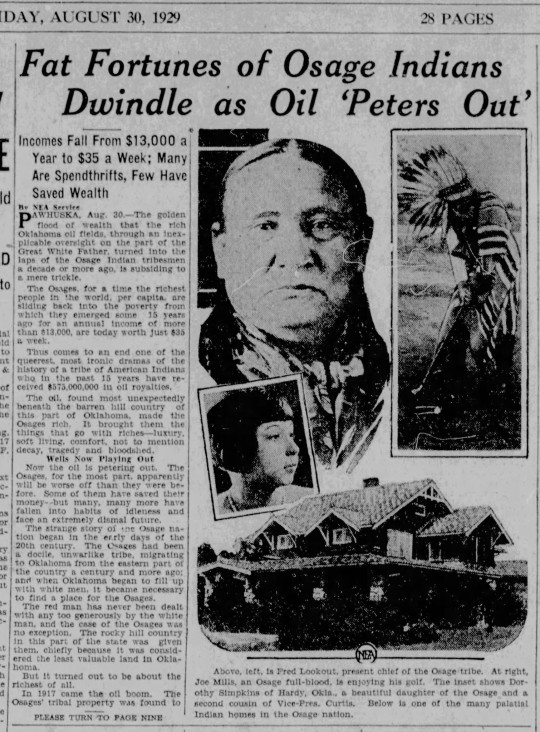
August 30,1929
#osage nation#osage#native american tribes#native#native american history#native americans#american history
21 notes
·
View notes
Text

January 6,1929
#osage nation#indigenous people#native americans#oil#native history#native american#american history
6 notes
·
View notes
Text

#booker t washington#black tumblr#black history#black literature#oklahoma#black excellence#black community#civil rights#black history is american history#black history month#blackexcellence365#newspaper#guthrie
15 notes
·
View notes
Text

#booker t washington#black tumblr#black history#black literature#black excellence#black community#civil rights#black history is american history#american history#black history month#newspaper
7 notes
·
View notes
Text

Taft Oklahoma. All black town early 1900s.
5 notes
·
View notes
